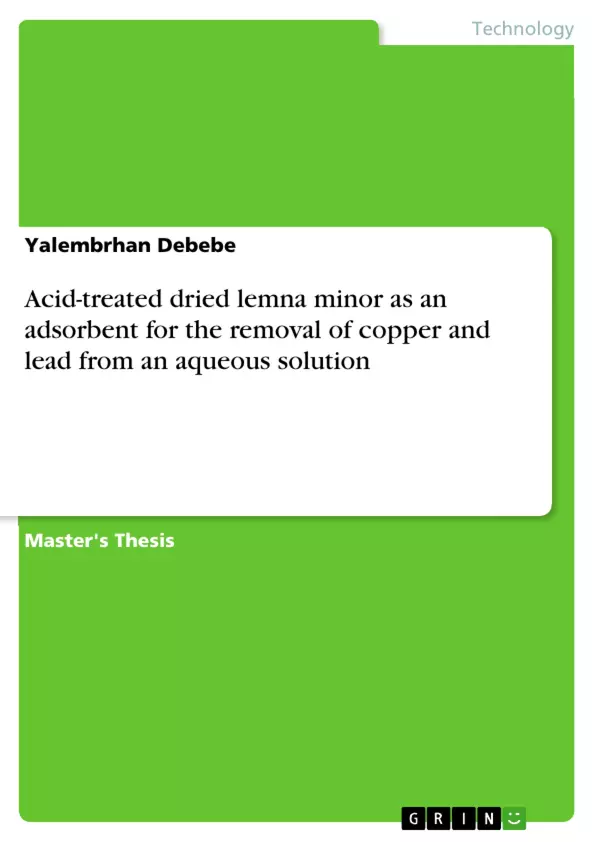The general objective of the thesis was investigation of acid treated lemna minor as an adsorbent for removal of Cu (II) and Pb (II) from aqueous solution. Are there sustainable and available bio adsorbents such as lemna minor (duckweed) that can be used for the removal of heavy metals? Can the emerging bio adsorbents actually replace activated carbon which is very expensive adsorbent common today? What is the optimum Operating parameters for biosorption of metal ions under batch studies
Heavy metals are chemical elements with a specific gravity that is at least 5 times the specific gravity of water and are toxic or poisonous even at low concentrations. With increasing generation of heavy metals from industrial activities, many aquatic environments face metal concentrations that exceed water quality criteria designed to protect the environment. They are highly dispersed in a wide variety of economically important minerals. They are released to the environment during mineral extraction process. Therefore, mining activities are the first anthropogenic source of heavy metals.
These heavy metals have potential health risks associated with metal uptake via food chain, dermal absorption or inhaling. High levels of exposure to heavy metals have been proved to cause cancer, organ damage, joint diseases, and in extreme cases, death. Several processes exist for removing dissolved heavy metals, including, ion exchange, precipitation, ultrafiltration, reverse osmosis, electro dialysis and activated carbon. Many of these approaches demand high energy, high cost, advanced operational requirements, result in large amounts of sludge requiring treatment or difficult to treat and be disposed of in an environmentally sound manner, or do not enable recovery of metals or material.
Inhaltsverzeichnis (Table of Contents)
- ACKNOWLEDGMENT
- 1. INTRODUCTION
- 1.1 Problem Statement
- 1.2 Research Questions
- 1.3 Objective
- 1.3.1 General Objective
- 1.3.2 Specific Objectives
- 1.4 Significance Of The Study
- 1.5 Scope Of The Study
- 2. Literature Review
- 2.1 Health and Environmental Effects Of Heavy Metals
- 2.1.1 Health Effects Of Copper
- 2.1.2 Health Effects Of Lead
- 2.2 conventional methods
- 2.3 Bio sorption of heavy metals
- 2.3.1 Merits Of Biosorption
- 2.3.2 Biosorbent Materials
- 2.3.3 Gaps In The Literature
- 2.4 Characteristics Of Lemna Minor
- 2.4.1 Previous study of Biosorption on to lemna minor
- 2.6 Factors Affecting Biosorption
- 2.5 Adsorption Mechanism
- 2.7 Adsorption Equilibrium Model
- 2.7.1 Adsorption Isotherms
- 2.7.2Adsorption Kinetics Models
- 2.1 Health and Environmental Effects Of Heavy Metals
- 3. MATERIALS AND METHODS
- 3.1 Equipment And Chemicals
- 3.2 Experimental Methods
- 3.2.1 Preparation Of Acid Treated Dried Powder Of Lemna Minor
- 3.3 Characterization Of Lemna Minor
- 3.3.1 Proximate Analysis Of Lemna Minor
- 3.3.2. Fourier Transform Infrared Spectroscopy (FTIR) Analysis Of Lemna Minor
- 3.3.3 X ray Diffraction Spectroscopy Analysis Of Lemna Minor
- 3.3.4 Point Of Zero Charge
- 3.3.5 Specific Surface Area
- 3.4 Preparation Of Aqueous Solution
- 3.5 Batch Adsorption Experiments
- 3.5.1 Effect Of pH On Metal Ion Adsorption
- 3.5.2Effect Of Initial Metal Ion Concentration
- 3.5.3 Effect Of Adsorbent Dose On Metal Ion Adsorption
- 3.5.4 Thermodynamics Studies
- 3.6 Adsorption Isotherms
- 3.7 Kinetic Studies On Metal Ion Adsorption
- 3.8 Experimental Design For Biosorption Study Of Copper And Lead
- 3.9 Desorption Of The Metals
- 4. Result and Discussion
- 4.1 Proximate Analysis
- 4.1.1 Point Of Zero Charge
- 4.2 FTIR Analysis
- 4.3 XRD Analysis
- 4.5 Surface Area Analysis
- 4.6 Effect Of pH
- 4.7 Effect Of Initial Metal Concentration
- 4.8 Effect Of Adsorbent Dose
- 4.9 Temperature Effects
- 4.10 Adsorption Equilibrium Studies
- 4.11 Thermodynamics Studies
- 4.12 Kinetic Studies
- 4.13 Desorption Study
- 4.14 Data Analysis Using Design Expert 6.0.8
- 4.14.1 Model Adequacy Check
- 4.14.2 Single And Interaction Effects
- 4.15 Optimization Of Percentage Removal Of Metal Ions
- 4.1 Proximate Analysis
- 5. Conclusion And Recommendation
- 5.1 Conclusion
- 5.2 Recommendation
- Reference
Zielsetzung und Themenschwerpunkte (Objectives and Key Themes)
This thesis investigates the potential of acid-treated Lemna minor as an adsorbent for removing Cu and Pb from aqueous solutions. The study aims to determine the effectiveness of this biomaterial for heavy metal removal and explores various factors influencing the adsorption process.
- Evaluation of acid-treated Lemna minor as a biosorbent for heavy metal removal
- Investigation of the impact of pH, initial metal concentration, adsorbent dosage, and temperature on adsorption
- Determination of adsorption isotherms and kinetics models to describe the adsorption process
- Assessment of the thermodynamic parameters associated with the adsorption process
- Optimization of the adsorption process for maximum removal of Cu and Pb from contaminated water
Zusammenfassung der Kapitel (Chapter Summaries)
- Chapter 1: This chapter introduces the problem of heavy metal contamination in water and outlines the research objectives. It emphasizes the need to develop effective and sustainable solutions for heavy metal removal.
- Chapter 2: This chapter provides a comprehensive review of the literature on the health and environmental effects of heavy metals, particularly copper and lead. It explores conventional methods for heavy metal removal and discusses the advantages of biosorption using plant materials.
- Chapter 3: This chapter details the materials and methods used in the study. It includes information about the preparation of acid-treated Lemna minor, characterization of the biosorbent, and the experimental procedures employed for batch adsorption studies.
- Chapter 4: This chapter presents the results and discussions of the adsorption experiments. It examines the influence of various factors on adsorption, including pH, initial metal concentration, adsorbent dose, and temperature. It also analyzes the adsorption isotherms, kinetics models, and thermodynamic parameters to understand the adsorption mechanism.
Schlüsselwörter (Keywords)
The key terms and concepts of this thesis include: heavy metal removal, biosorption, Lemna minor, adsorption, isotherms, kinetics, thermodynamics, copper, lead, wastewater treatment, environmental remediation.
- Arbeit zitieren
- Yalembrhan Debebe (Autor:in), 2018, Acid-treated dried lemna minor as an adsorbent for the removal of copper and lead from an aqueous solution, München, GRIN Verlag, https://www.grin.com/document/430754



